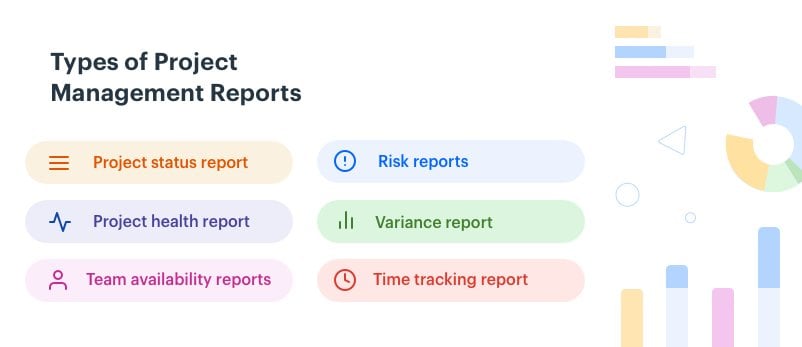Project Reporting
In project management, reporting is the process of presenting a high-level summary of the necessary critical data the project produces in an understandable, straightforward manner. Project management depends on project reporting since it offers a window into what is happening and what to do about it for the whole team.
Simplified, smart project reporting made possible by project management software with reporting capabilities helps better manage projects.
For what reason is project management dependent on project reporting ?
Inadequate project management reports cause the project team and project stakeholders to remain in the dark, unable to sense what is happening with the project. Therefore, it is all too easy for the project to fail just because the correct insights aren’t coming through and hence, suitable judgments aren’t being done.
Project reporting satisfies the information demand in the process of project management so that data is gathered from where it is produced and sent to where it is analyzed and used.
Project management reports are rather significant overall since they:
- Show the project team what they are doing so they may justify why it is working and concentrate more on it.
- Reveal what is not working so the team may look into and decide on a suitable course of action—that is, what to do about it using the project dashboard.
- Provide the team with a 360° perspective of the state of the project thereby guiding their future actions.
Various Project Management Reporting Forms
The reports you will need to oversee your initiatives are compiled here, together with some insightful analysis of each.

1. Report on Project Status
A crucial document that provides a broad picture of how effectively the project is moving toward its goals is the project status report, which shows stakeholders. Considered as a general update meant to keep stakeholders or project progress, developing issues, and important points of attention all at once, the project status report is like.
2. Project Health Evaluation
Designed to inform stakeholders on the general state of the project, project health reports reflect whether the project is either moving as expected, in risk of stagnating or totally stagnated.
Why would you want project health reports ?
The following queries are addressed by the project health report:
- Are we headed toward delivering this project on schedule? Has our stagnancy been evident?
- How far are we from the target?
- What must be given most focus if we are to return on track?
Project health reports help the team to quickly see problems so they may decide what and clear the path.
3. Team Availability Records
Like a team calendar displaying every team member’s schedule, the team availability report helps one to easily identify who is busy and when. Stakeholders planning for a project or needing input anywhere may thus see which team members can be assigned, those who can safely take on extra work, as well as those who are at full capacity and could require help.
Why do you require information on team availability?
Availability reports help one to see how much everyone has on their plates, thereby enabling more equitable distribution of work to attain fastest outcomes, greater efficiency, and most significantly, prevent project fatigue across teams. An availability report shows personnel names against calendar days using either a written designation or a color tone to indicate their daily workload.
4. Risk Documentation
A risk report points out the obstacles to the effective completion of a project and offers them for review among the stakeholders. Apart from showing current or possible challenges, the risk report aims to provide a sense of the danger they create for the project so that the stakeholders of the project may act appropriately to remove project hazards or modify the project.
Why do risk reports matter?
Project risk reporting supports the project team in:
- Finding both current and possible project restrictions holding back the project or those likely to do so.
- Plotting challenges on a risk scale to decide which ones to give top priority.
- Finding ways to avoid such problems in next initiatives.
5. Variance Summary
Teams can stray from the main objectives of the project without even knowing. After time and money have been spent, this finally causes project failure.
A variance report guarantees that none of this happens by helping the project team and stakeholders. Along with the ongoing activity, you can monitor the desired project milestones and objectives.
Why do variance reports matter?
Using a variance report, the team can determine whether their efforts truly reflect the goals of the project or whether they are only wasting time without fulfilling the following:
- Project deliverables
- Project goals
- Project milestones
6. Report on Time Tracking
Tracking project time enables the project team and stakeholders to observe team member time consumption at all phases of the project management process. By means of a time monitoring report, the team can observe the total time spent on particular tasks as well as the individual team member expenditure on them.
Time monitoring reports enable you to assign team members to activities where they are most effective, therefore optimizing resources. Monitoring time dedicated to work for pay.
How Should One Produce Good Project Reports ?
Project reporting seeks to provide all the data produced by your initiatives in an easy-to-understand style so stakeholders may use such insights. These best practices will enable you to produce reports that really enable project stakeholders to make informed decisions.
1. Keep data in the middle :
Project management reports seek to provide processed data to people who need it so they may be educated and base suitable decisions from it. Reports should show accurate information for which stakeholders may review to obtain a sense of the whole picture.
2. Picture the facts visually :
Using visual project management tools, apply a lot of graphics, graphs, and charts wherever suitable to thoroughly show the consequences of whatever data you provide.
3. Let the stage remain open for honest communication :
Reports should aim to explain the data and its ramifications while inviting more inquiries, not to be full stops spitting out facts and getting over with it. Although it could be challenging, this guarantees that project cooperation across stakeholders is in line and provides a whole picture of what you are trying to transmit.
4. Write reports fit for your readership:
Senior-level management won’t have the time to sort through minute details; team members won’t be able to make much of use of a report showing just a few figures, project management charts, and notes. Reports must be tailored to the demands of your particular audience so they acquire all the information they need through project communication management, without becoming mired in detail or left in the dark with inadequate data.
Using good project management tools helps you to manage your projects with great advantage over the competition and makes it rather simple to complete tasks instead of spending hours traversing your project management tool or carefully entering figures one-by-one on spreadsheets.
Not only do these tools make beautiful reports simple, but they also take all of your data and present it in an understandable style with only a single click.


